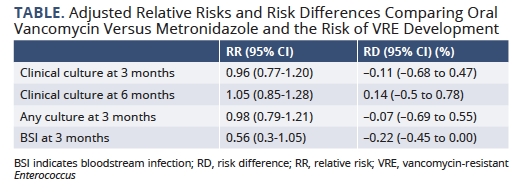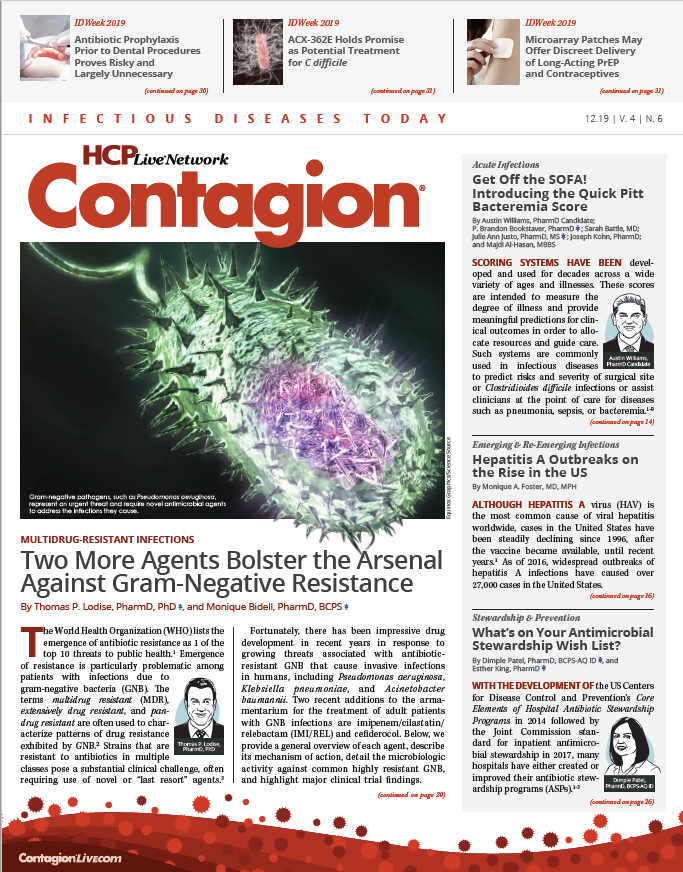Entering the Ring: Oral Vancomycin Versus Metronidazole for C difficile Infection and the Risk of Vancomycin-Resistant Enterococcus
In 2017, a guideline update stripped metronidazole of its first-line therapy designation and crowned oral vancomycin as initial therapy for all C difficile infection cases.
Highlighted study: Use of oral vancomycin for Clostridioides difficile infection (CDI) and the risk of vancomycin-resistant Enterococci (VRE)
Stevens VW, Khader K, Echevarria K, et al. Clin Infect Dis. 2019; pii: ciz871. doi: 10.1093/cid/ciz871.
Clostridioides difficile infection (CDI) continues to be a tough arena among health care-associated infections and is classified as a major health threat by the US Centers for Disease Control and Prevention. Traditionally, to combat CDI, oral metronidazole was a top contender, recommended as first-line therapy for mild to moderate cases (now known as nonsevere), reserving oral vancomycin for severe CDI.1 In 2017, however, a guideline update stripped metronidazole of its first-line therapy designation and crowned oral vancomycin as initial therapy for all CDI cases.2
Some providers already regarded oral vancomycin as the champion treatment, but others had concerns about increased indi­vidual and health care costs and emergence of vancomycin-resistant Enterococcus (VRE) from routine use of oral vancomycin. In litera­ture, a link between vancomycin exposure and an increased risk of VRE has been suggested, but these studies have many limitations, such as small populations, heterogeneity, and little to no oral vancomycin representation.3-5 Oral metronidazole has also been associated with VRE growth and colonization, further clouding predictions of the effect of a widespread prac­tice change.5,6
To address the concern of increased clini­cally relevant VRE infection risk with routine oral vancomycin use, Stevens and colleagues generated a direct matchup between oral metronidazole and vancomycin. The retro­spective, multicenter, propensity-matched cohort study included inpatients, long-term care residents, and outpatients of the US Department of Veterans Affairs (VA) Health System who received a diagnosis of CDI from January 2006 to December 2015. Patients who tested positive for CDI toxin and were treated with oral vancomycin or intravenous or oral metronidazole within 14 days after diagnosis were included. Patients who did not receive treat­ment and had a history of VRE in the past year were excluded.
CDI episodes were categorized by loca­tion of symptom onset, episode type, and year of diagnosis. Maximum white blood cell count (WBC) and maximum and average serum creatinine (SCr) values were used as markers of CDI severity. Multiple imputation was used to estimate missing values, and 50 imputed data sets were gener­ated, with propensity score matching of 1 vancomycin-treated patient to up to 2 metronidazole-treated patients in each set. The primary outcome was presence of posi­tive VRE clinical cultures at 3 and 6 months after CDI treatment initiation. Isolation of VRE from blood and surveillance cultures at 3 months after treatment initiation was also evaluated.
A total of 82,405 patients met inclusion criteria, and 15,776 were included in the propensity score—matched final analysis, with 5,266 patients receiving oral vancomycin and 10,510 receiving metronidazole. Patients were primarily male (95%), with a median age at diagnosis of 69 years. A majority of CDI cases were initial episodes (99%) with a commu­nity onset (70%). The median maximum WBC, maximum SCr, and average baseline SCr were ~11 103 cells/mL3, 1.20 mg/dL, and 1.10 mg/dL, respectively. Baseline charac­teristics in the matched cohort, including receipt of fluoroquinolones, cephalosporins, and proton pump inhibitors in the previous 3 months, were similar between groups.
Compared with metronidazole, oral vanco­mycin was not associated with an increased risk of VRE in clinical cultures at 3 months (adjusted relative risk [aRR], 0.96; 95% CI, 0.77-1.20; absolute risk difference [RD], 0.11%; 95% CI, —0.68 to 0.47) or 6 months (aRR, 1.05; 95% CI, 0.85-1.28; RD, 0.14%; 95% CI, –0.5 to 0.78) (Table). Similarly, there was no increased risk of VRE bloodstream infection with oral vancomycin treatment (aRR, 0.56; 95% CI, 0.3-1.05; RD, —0.22%; 95% CI, –0.45 to 0.00) or 3isolation of VRE from surveillance cultures (aRR, 0.98; 95% CI, 0.79-1.21; RD, –0.07%; 95% CI, –0.69 to 0.55) at 3 months. These findings were consistent across predefined sensitivity analyses, excluding the top 10 surveillance facilities and including only incident cases.
The retrospective, observational design is a limitation of this study, but the authors attempted to adjust for confounders with propensity score matching. Additionally, data collection was limited by imperfect provider documentation over time. Given the predom­inantly male, comorbidity-heavy VA popula­tion, generalizability to other patient groups is limited. VRE colonization status was also unable to be collected due to variability in facility surveillance practices, and this study was not designed to evaluate oral vancomycin treatment effects on VRE transmission. CDI was defined using laboratory measures only and did not evaluate symptomatic presenta­tion; however, authors adjusted for this factor by excluding patients who did not receive CDI treatment. Lastly, this study focused on vanco­mycin treatment and not vancomycin prophy­laxis, which is often dosed less frequently. Whether vancomycin prophylaxis against CDI perpetuates VRE acquisition is unknown.

Infectious diseases providers and anti­microbial stewards are growing increas­ingly nervous as antimicrobial resistance increases. This study offers some reassurance that the newly recommended practice of first-line treatment of all cases of CDI with broader-spectrum oral vancomycin may not have negative individual and ecologic effects on VRE risk. Although concerns over the optimal agent for treatment are valid, a focus on diagnostic stewardship and efforts to discontinue therapy in patients without true CDI should be prioritized minimize the risk of multidrug-resistant organism development.
Britt is a Pharmacy Clinical Specialist in Infectious Diseases at The University of Texas Medical Branch in Galveston, Texas. Interests include antibacterial agents, antimicrobial stewardship, and queso. Find her on Twitter @RachelBPharmD.
*Britt is an active member of the Society of Infectious Diseases Pharmacists.
References
- Cohen SH, Gerding DN, Johnson S, et al; Society for Healthcare Epidemiology of America; Infectious Diseases Society of America. Clinical practice guidelines for Clostridium difficile infection in adults: 2010 Update by the Society for Healthcare Epidemiology of America (SHEA) and the Infectious Diseases Society of America (IDSA). Infect Control Hosp Epidemiol. 2010;31 (5):431—455. doi: 10.1086/651706.
- McDonald LC, Gerding DN, Johnson S, et al. Clinical practice guidelines for Clostridium difficile infection in adults and children: 2017 update by the Infectious Diseases Society of America (IDSA) and Society for Healthcare Epidemiology of America (SHEA). Clin Infect Dis. 2018;987-994. doi: 10.1093/cid/ciy149. doi: 10.1001/archinte.159.20.2461.
- Carmeli Y, Samore MH, Huskins C. The association between antecedent vancomycin treatment and hospital-acquired vancomycin-resistant enterococci: a meta-analysis. Arch Intern Med. 1999;159:2461-8. doi: 10.1001/archinte.159.20.2461.
- Harbarth S, Cosgrove S, Carmeli Y. Effects of antibiotics on nosocomial epidemiology of vancomycin-resistant enterococci. Antimicrob Agents Chemother. 2002;46(6):1619-1628. doi: 10.1128/aac.46.6.1619-1628.2002.
- Al-Nassir WN, Sethi AK, Li Y, Pultz MJ, Riggs MM, Donskey CJ. Both oral metronidazole and oral vancomycin promote persistent overgrowth of vancomycin-resistant Enterococci during treatment of Clostridium difficile-associated disease. Antimicrob Agents Chemother. 2008;52 (7):2403-2406. doi: 10.1128/AAC.00090-08.
- McKinnell JA, Kunz DF, Moser SA, et al. Patient-level analysis of incident vancomycin-resistant enterococci colonization and antibiotic days of therapy. Epidemiol Infect. 2016;144(8):1748-1755. doi: 10.1017/S0950268815003118.

